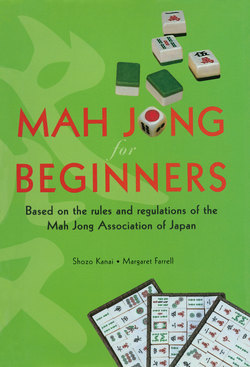Читать книгу Mah Jong for Beginners - Shozo Kanai - Страница 12
На сайте Литреса книга снята с продажи.
ОглавлениеCHAPTER V.
DEAL AND ARRANGEMENT OF THE TILES
Now to go ahead with the game. There are 136 tiles and they should be well mixed. Each player gathers 34 tiles to form two rows of 17 each, placing one row on top of the other. For ease in assembling the tiles it is well to remember to pick up three upside down tiles in each hand twice, then three in one hand and two in the other. This makes a row of 17. Thereafter, we can speedily pick up the other 17 tiles (All of the tiles are assembled face down).
Arrangement of tiles
On finishing the arrangement, East casts the two dice to decide from where to commence to pick up the tiles. Counting the number or spots, starting with East and counting to the right, the person thus nominated casts the dice again. Adding the number of spots from both castings, and counting off that number from the right end of the nominated pile, indicates the place from which East starts taking the tiles to make up his hand.
For example, the Eldest Hand, or East, casts the dice and the spots add up to 6. The sixth player, namely South, casts dice again and the spots add up to 7. Then East takes two piles (4 tiles), EXCLUDING 13 PILES, from the right end of the row of piles in front of South. South takes the next two piles (4 tiles), then West and North take successively. Each takes thrice in order to have 12 tiles, then East takes one tile from the upper part of the pile, South takes one from the lower part and West and North take their last tile each, so that each player has 13 tiles.
There should always be 13 tiles in each hand, including melds, except in the case of:—
a. Kan (4 of a kind, which will be explained later)
b. Going Out and
c. Picking up from the pile.
However, East takes one more tile to make 14. To simplify the dealing, East takes two tiles successively after the four players have taken four tiles thrice.
At the beginning of the game, East has 14 tiles and the other three players have 13. These are placed upright in a line in front of each player with the bamboo backs shown to the opposite side. The 13 tiles are first placed at random in the order of picking up. Later they should be arranged in order to be easily understood. However, the arrangement should be avoided after making progress as others can guess what part is Bamboo or what part is composed of Letter tiles, when one picks up a tile for discarding or for melding. Much exercise is needed to play without arrangement.
Arrangement of Hands
